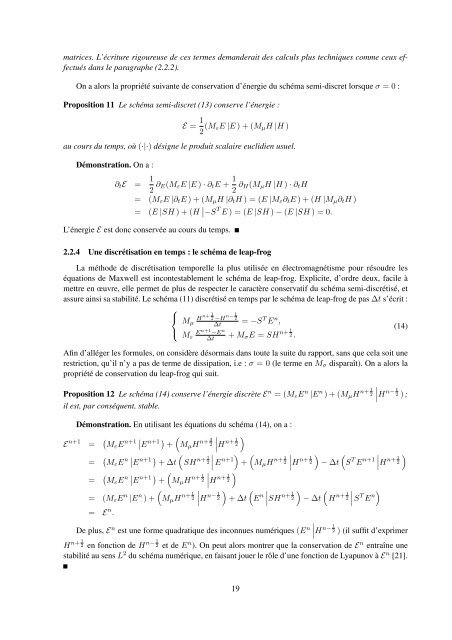Etude de méthodes de pas de temps local dans un schéma Galerkin ...
Etude de méthodes de pas de temps local dans un schéma Galerkin ...
Etude de méthodes de pas de temps local dans un schéma Galerkin ...
- No tags were found...
You also want an ePaper? Increase the reach of your titles
YUMPU automatically turns print PDFs into web optimized ePapers that Google loves.
matrices. L’écriture rigoureuse <strong>de</strong> ces termes <strong>de</strong>man<strong>de</strong>rait <strong>de</strong>s calculs plus techniques comme ceux effectués<strong>dans</strong> le paragraphe (2.2.2).On a alors la propriété suivante <strong>de</strong> conservation d’énergie du schéma semi-discret lorsque σ = 0 :Proposition 11 Le schéma semi-discret (13) conserve l’énergie :E = 1 2 (M εE |E ) + (M µ H |H )au cours du <strong>temps</strong>, où (·|·) désigne le produit scalaire euclidien usuel.Démonstration. On a :∂ t E = 1 2 ∂ E(M ε E |E ) · ∂ t E + 1 2 ∂ H(M µ H |H ) · ∂ t H= (M ε E |∂ t E ) + (M µ H |∂ t H ) = (E |M ε ∂ t E ) + (H |M µ ∂ t H )= (E |SH ) + (H ∣ ∣−S T E ) = (E |SH ) − (E |SH ) = 0.L’énergie E est donc conservée au cours du <strong>temps</strong>.2.2.4 Une discrétisation en <strong>temps</strong> : le schéma <strong>de</strong> leap-frogLa métho<strong>de</strong> <strong>de</strong> discrétisation temporelle la plus utilisée en électromagnétisme pour résoudre leséquations <strong>de</strong> Maxwell est incontestablement le schéma <strong>de</strong> leap-frog. Explicite, d’ordre <strong>de</strong>ux, facile àmettre en œuvre, elle permet <strong>de</strong> plus <strong>de</strong> respecter le caractère conservatif du schéma semi-discrétisé, etassure ainsi sa stabilité. Le schéma (11) discrétisé en <strong>temps</strong> par le schéma <strong>de</strong> leap-frog <strong>de</strong> <strong>pas</strong> ∆t s’écrit :⎧⎨ HM n+ 1 2 −H n− 1 2µ ∆t= −S T E n ,(14)⎩ EM n+1 −E nε ∆t+ M σ E = SH n+ 1 2 .Afin d’alléger les formules, on considère désormais <strong>dans</strong> toute la suite du rapport, sans que cela soit <strong>un</strong>erestriction, qu’il n’y a <strong>pas</strong> <strong>de</strong> terme <strong>de</strong> dissipation, i.e : σ = 0 (le terme en M σ disparaît). On a alors lapropriété <strong>de</strong> conservation du leap-frog qui suit.Proposition 12 Le schéma (14) conserve l’énergie discrète E n = (M ε E n |E n ) + (M µ H n+ 1 ∣2 ∣H n− 1 2 ) ;il est, par conséquent, stable.Démonstration. En utilisant les équations du schéma (14), on a :E n+1 = ( M ε E n+1 ∣ ∣E n+1 ) ()+ M µ H n+ 3 ∣2 ∣H n+ 1 2= ( M ε E n ∣ En+1 ) (+ ∆t SH n+ 1 2 ∣ E n+1) (+ M µ H n+ 1 2= ( M ε E n ∣ ∣E n+1 ) ()+ M µ H n+ 1 ∣2 ∣H n+ 1 2()= (M ε E n |E n ) + M µ H n+ 1 ∣2 ∣H n− 1 2 + ∆t= E n .) ( ∣ )∣∣H n+ 1 2 − ∆t S T E n+1 ∣∣H n+ 1 2( ∣ ) (E n ∣∣SH n+ 1 2 − ∆tH n+ 1 2∣ S T E n)De plus, E n est <strong>un</strong>e forme quadratique <strong>de</strong>s inconnues numériques (E n ∣ ∣∣H n− 1 2 ) (il suffit d’exprimerH n+ 1 2 en fonction <strong>de</strong> H n− 1 2 et <strong>de</strong> E n ). On peut alors montrer que la conservation <strong>de</strong> E n entraîne <strong>un</strong>estabilité au sens L 2 du schéma numérique, en faisant jouer le rôle d’<strong>un</strong>e fonction <strong>de</strong> Lyap<strong>un</strong>ov à E n [21].19


